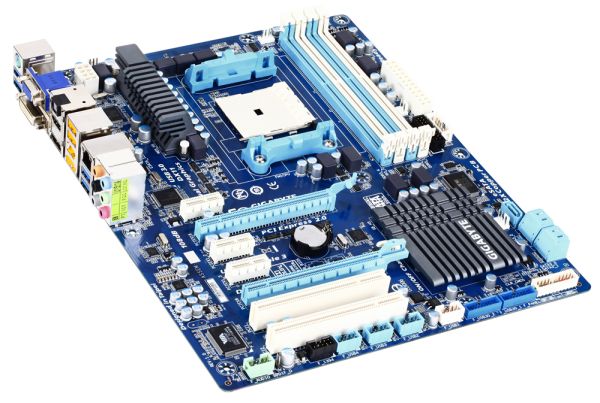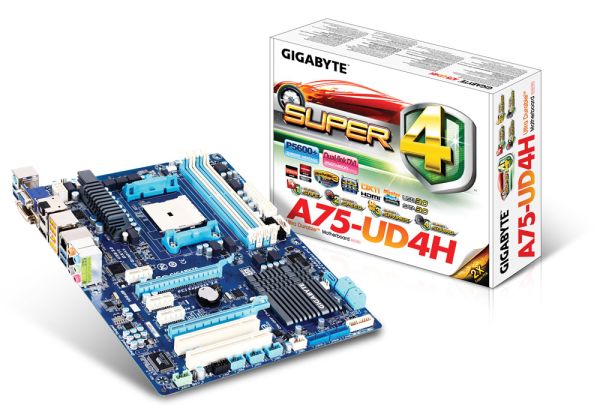ASUS F1A75-V Pro vs. Gigabyte GA-A75-UD4H – Llano at ~$120
by Ian Cutress on November 7, 2011 6:00 AM EST- Posted in
- Motherboards
- Gigabyte
- Asus
- A75
Overview of the Gigabyte GA-A75-UD4H
After having this board on the review test bed for a few days now, nothing immediately strikes me from the Gigabyte board. The overclock capability was quite good, despite the lack of overclock options.
The PCIe layout is a good one from which some other motherboard manufacturers can learn, and the IO panel is nicely full of USB ports. The position of the SATA port sticking out of the board, and the fan header next to it, is such that a second GPU will not hinder them. This also shows that some thought has gone to this area of the board!
I am quite disappointed by the fan control, especially compared to the ASUS board, which on this GA-A75-UD4H is limited in the BIOS and not expanded thoroughly by software in the OS. The BIOS is also still the old non-graphical style, and we’ll have to wait until X79 to get our hands on what Gigabyte has done in that respect.
At $115, the GA-A75-UD4H represents a board of good design, a three year warranty, but is let down by the options offered by software.
Visual Inspection
In terms of visuals, the GA-A75-UD4H sports a blue and white livery indicative of Gigabyte’s non-high end motherboards.
The 8+2 PWM design powers the large AMD socket, with VRM heatsinks which rock fairly easily under pressure. Around the socket are three fan headers, a SYS fan on the top left, a CPU fan in the top right and a PWR fan to the right of the DIMM slots. The socket area is fairly clear, allowing for large air coolers as required.
The GA-A75-UD4H sports a TPM header, and five SATA 6 Gbps ports. Four of these ports are at 90º to the board, and the other sticks out of it. The position of this port is such that if the user has two large PCIe cards in the board, this port is still accessible, as well as the SYS fan next to it.
The PCI/PCIe slot layout is a good choice for this board, with a PCIe x1 at the top, then a PCIe x16, two PCIe x1, another PCIe x16 (down to x8/x8 in dual GPU mode), and two PCI slots at the bottom. This allows sufficient space between dual GPU setups, as well as the top PCIe x1 for a first x1 card.
The IO panel is full of ports, namely 4 USB 3.0 (blue), two USB 2.0 (yellow), a PS/2 port, VGA, DVI-D, HDMI, DisplayPort, a S/PDIF optical output, an eSATA 6 Gbps port, FireWire, a Realtek gigabit Ethernet port, and typical audio jacks. I would have liked to see a Clear CMOS button, but with the IO this packed, I do not think there is space for it, unless they removed some features. It should be noted that, according to the Gigabyte website, the DVI-D does not support D-Sub by adaptor, and that when on integrated graphics, the connector cannot be changed while the motherboard is powered up.













47 Comments
View All Comments
Taft12 - Wednesday, November 9, 2011 - link
An F1 socket board with 3 PCI-E x16 slots? Consider my face palmed.Googer - Sunday, November 13, 2011 - link
ASUS and ASROCK have FM1 boards with 3 PCI-e x16 slots. There maybe another, but I'm not aware.Googer - Wednesday, November 9, 2011 - link
"The Gigabyte board wins again in our USB 3.0 testing."Since the ASUS uses two separate USB3 controllers, one on chipset, the other an ASmedia USB3 PCI-e. Peformance can vary based on which port you plug in to. If I remember correctly, the front Panel and ports near the PS2 port is the other ASmedia USB3 port. A little retesting is certainly needed here.
Etern205 - Wednesday, November 9, 2011 - link
I've notice there are four display outputs, VGA, DVI, HDMI, and Display Port. What is the maximum number of displays you can use at one time just by using the IGP?Not doing for eyefinity, but for 3 separate monitors.
Thanks
Googer - Sunday, November 13, 2011 - link
I haven't tested it but on my ASUS, I think the limit is 2 with out discreet graphics. However, I could be wrong on this.crtune - Sunday, November 13, 2011 - link
It really depends upon the device. I have an Echo Audio Mia card from several years ago, which while not having exactly every feature a newer card would have, has profoundly excellent audio quality. For the type of audio I work on (2+1 traditional stereo; mostly demo recordings, documenting gigs I'm on and so forth) this audio card is ideal and really I do not want to spend the several hundred on a newer one which will meet the standards I have for audio cards (in Los Angeles, CA as a musician I compete with people who have top quality audio gear). NONE of the onboard audio, on even the best on-board audio set ups will be as noise free and low latency as the audio I'm getting using this old card.So, now you should understand why someone might want to use legacy PCI bus hardware devices.
swaaye - Tuesday, November 15, 2011 - link
The people who think "legacy" ports are bad aren't going to be convinced otherwise unless they have their own reason for using them. This topic comes up endlessly.